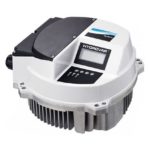How do variable speed drive (VFD) pumps work ?
With nearly half of the world’s energy consumption attributed to motors and a larger percentage of these fitted to pumps, the introduction of variable speed drives has made a huge impact on the efficiency and reliability of pumping systems globally.
Ever wondered why most cold water booster sets and many circulator pumps all use this technology? This blog will give you a guide on how they work, why they’re used and where they are best used.
Variable Speed Drives Vs. Variable Frequency Drives
Variable speed drives (VSD) and variable frequency drives (VFD) adjust the speed of the motor by controlling the input supply voltage to the motor. VSD’s adjust the input voltage only and VFD’s adjust both the input voltage and frequency. VFD’s can only be used with AC motors, VSD’s can be used for both AC and DC motors.
The majority of motors used in larger domestic, commercial and industrial applications are AC and therefore VFD’s are more common. However, most of the time the term VSD and VFD is used interchangeably.
Variable Speed/Frequency Drives In Pump Systems
So, why are variable speed drives becoming more and more popular in pumping systems. Standard electric motors running at a fixed speed are perfect for systems where a consistent output speed is required (for example a conveyor belt).
However, for pump systems where the demand will vary substantially a fixed speed motor running at the same constant speed is likely to be generating wasted energy. So by reducing the motor speed to match the demand as it fluctuates, will increase the efficiency.
A good example of this is a pump fitted to a boosted cold water system for a multi-occupancy residential property. As demand from showers, taps and other services are used first thing in the morning, an inverter driven pump will increase and decrease the motor speed accordingly to maintain the system pressure as the demand increases.
As the demand from services drops again during the day, the pump speed will reduce, increasing efficiency. Importantly, a variable speed drive that has been commissioned correctly will ensure the pump actually stops if there is zero demand, rather than letting the motor ‘idle’.
Variable speed drives are also very useful for applications where two or more pumps are required for a particular duty (for example a triple pump cold water booster set). In these applications inverters can be fitted to all the pumps on this system, and commissioned so that each inverter can communicate with the other inverter(s). This has many uses, but primarily to manage the pumps to ensure demand is met by starting/stopping the other pumps, and secondly to ensure the mechanical wear/run-time is distributed evenly across the pumps.
Many inverters also have built in alarm signals and Building Management System (BMS) interface. This improves the speed of fault detection in pump systems, the ability to troubleshoot quickly and reduce the risk of catastrophic failure of any rotating equipment.
Installation & Cooling
In pumping system applications, inverter drives are commonly either motor-mounted, wall-mounted or fitted inside an enclosure.
VSDs generate a heat and is largely why they are normally limited to 95% efficiency, with the remaining 5% being lost in heat generation. Cooling is therefore a central part of ensuring the inverter functions correctly.
When the inverter is motor mounted (usually on top of the fan cowl), the inverter relies on a heat sink with fins and the motor fan for cooling. If an inverter is wall mounted, sometimes a separate fan will need to be fitted alongside the mounting brackets. However, many wall-mounted inverters have built in fans.
Water-cooled inverters (as the name would suggest) do not use a fan cooling mechanism. Instead the inverters, often fitted inline on discharge pipework, are simply cooled by the passing water. These are however becoming less commonly used in recent years.
With modern efficiencies, inverters are becoming more compact in style, enabling them to be fitted inside control panels. This has many benefits, but primarily they save space, additional installation time and are protected by the panel enclosure.
Integrated Motors & Inverters
Many pump manufacturers are now moving to motor manufactured with an integral VSD. Although normally speaking non-integrated inverters are just as efficient as integrated inverters, they are gaining popularity for three main reasons:
- As many modern pumping systems are specified with variable speed pumps, standardising on pumps with integrated inverters saves space and additional design work and simplify the installation.
- Additionally, pumps with integrated VSD’s enable manufacturers and suppliers to pre-commission the pump to the exact required duty prior to shipment to site which saves install time and costs.
- Variable speed drives are used in many different applications, and restricting the programming options to those relevant to pumping applications makes them easier to programme and less likely to be commissioned incorrectly.
How Much Money Could Be Saved?
So as an example a 7.5kW 2 pole motor running at full speed and full load could cost approximately £1 per hour to run. If the applications allows the pump to be run at 90% of full speed the power consumed will be approximately (90% x 90% x 90%) 73% or £0.73 per hour. In this example over the course of a year a saving of >£2,300 could be made.
Problems with Variable Speed Drives
Most of the problems associated with VSD’s are far outweighed by the benefits, but there are a few disadvantages to be aware of:
- There is normally a large cost associated with the addition of an inverter to a pump. Sometimes the inverter can be greater the cost of the pump/motor assembly alone! However, normally speaking this is quickly compensated by the energy savings made over a period of time.
- A variable speed drive is a sensitive and complex electronic piece of equipment and is vulnerable if subjected to repeated power cuts, power surges and lightning strikes and any ingress of moisture. Most drives are fitted with harmonic filters to prevent interference with other electronic equipment caused by voltage harmonics generated by the drive, so this is a consideration and occasionally causes issues.
- There is the assumption that before long all motors will be fitted with variable speed drives to ‘improve efficiency’. This is unlikely to happen as many pump systems and other installations are fitted with rotation equipment correctly designed to run at full speed, and therefore run at optimum efficiency already. A correctly-sized fixed speed pump will be more efficient if demand is absolutely consistent.
In conclusion, variable speed drives will become more and more prevalent in systems containing rotating equipment as we strive for a more sustainable and energy efficient world. However, we have only really scratched the surface of this vast topic – pleas get in touch today if you have any further questions!
www.tradepumps.com/spares/pump-controls/variable-speed-drives
Tradepumps.com
FREEPHONE 0808 250 0669
References: https://www.sciencedirect.com/topics/engineering/electric-energy-consumption









